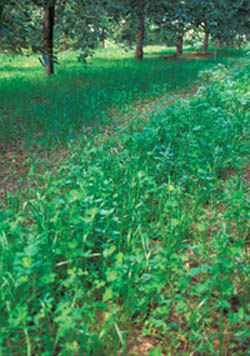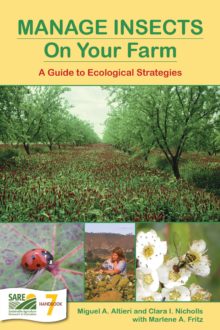
Innovative Tart Cherry Orchard Systems
Michigan State University scientists have evaluated orchard-scale ground cover experiments in established commercial orchards and in a new tart cherry orchard at the Northwest Horticultural Research Station. They studied orchard floors covered with compost, mulch or cover crops such as crimson clover, berseem clover, white clover, white Dutch clover, Michigan red clover, crown vetch, indigo vetch, alfalfa, rye, annual ryegrass, hard fescue and Buffalo grass. So far, findings include:
- Season-long populations of beneficial mites were attributed to the use of a red clover cover crop.
- Season-long, vegetation-free strips using either herbicide or mulch increase pest mite populations.
- Orchards with ground covers—irrigated but not treated with herbicides to manage weeds—had fruit yields that were not significantly lower than conventional practices over a five-year period. Note the irrigation may be critical in this system to prevent the ground cover from competing with the fruit trees for water.
- Adding mulch, cover crops and/or compost increases soil organic matter, populations of beneficial soil microbes and amounts of active soil carbon and nitrogen available to trees.
- Fewer beneficial nematodes, more plant-parasitic nematodes and more nitrate leaching were associated with lower-quality conventional-system soils.
- Hay or straw mulch, applied 6 to 8 inches deep, improved tree growth and yields despite higher pest mite populations.
- Nitrate leaching—greatest in spring and fall—was substantially reduced by vegetation growing under trees during these periods.
- In-row soil population densities of beneficial nematodes, mycorrhizae and earthworms were greater under an organic production system.
- Young trees benefited from adding mulch or compost but can be severely stunted by competition with groundcover plants for moisture and nutrients.
- Trees with heavy mulches produced soft fruit in two of seven years.
The scientists also are examining the impact of mixed-species hedgerows on insect pest movement into and out of orchards. In addition, they are evaluating insect pheromone mating disruption, mass trapping of plum curculio, 14-inch groundcover bands around mulched center lines, and intercropping with such income-generating woody species as sea buckthorn and Siberian pea.
Orchards offer advantages over annual row crops in biological pest control, says MSU IPM tree fruit integrator David Epstein. Because they do not undergo major renovation every year, orchard systems can be developed to let beneficials get established. “Ground covers can be used to encourage beneficials to build up their populations and remain in the orchard throughout the year,” he says.
How much the beneficials actually reduce pests, however, depends on weather, pest populations and the effectiveness of growers’ monitoring programs. “To say that if you plant red clover you’ll never have to spray for mites again would be erroneous,” says Epstein. “But if you know what’s out there—what levels of pests, predators and parasitoids you have—then you can make an informed decision as to whether or not you can save a spray.”
